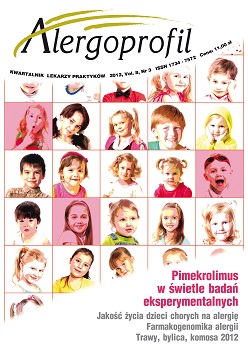The concentrations of airborne fungal spores in the indoor air
Main Article Content
Abstract
Microbiological indoor air quality significantly affects the health and well-being of people utilize the space and plays a leading role in the food, pharmaceutical and cosmetic production. Fungal spores which often occur together with the bacteria, may be the cause of many diseases, such as allergy. Effects of epidemiological studies have shown that the „sick building syndrome” and sensitivity to disease (including asthma) are directly related to exposure to high concentrations of bacteria and fungi in the indoor air.
Downloads
Article Details
Copyright: © Medical Education sp. z o.o. This is an Open Access article distributed under the terms of the Attribution-NonCommercial 4.0 International (CC BY-NC 4.0). License (https://creativecommons.org/licenses/by-nc/4.0/), allowing third parties to copy and redistribute the material in any medium or format and to remix, transform, and build upon the material, provided the original work is properly cited and states its license.
Address reprint requests to: Medical Education, Marcin Kuźma (marcin.kuzma@mededu.pl)
References
2. Yankova R., Peneva R.: Allergenic air borne spores in Sofia: preliminary report. Mik. Lek. 1996, 3: 13-17.
3. Herrero B., Fombella-Blanco A., Fernandez-Gonzalez D., Valencia-Barrera R.M.: Aerobiological study of fungal spores from Palencia (Spain). Aerobiologia 1996, 12: 27-35.
4. Fernandez D., Valencia M.R., Molnar T., Vega A., Sagues F.: daily and seasonal variations of Alternaria and Cladosporium airborne spores in Leon (North-west Spain). Aerobiologia 1998, 14: 215-220.
5. Rubulis J.: Airborne fungal spores in Stockholm and Eskilstuna, central Sweden. Nordic Aerobiology 1984: 85-93.
6. Baka G., Syrigou E., Manoussakis M.: Airborne fungus spores in Athens area 1995-1997. European Journal of Allergy and Clinical Immunology, Supplement (Kopenhaga) 1998, 43(58): 21-2.
7. Nikkels A.H., Terstegge P., Spieksma F.Th.M.: Ten types of microscopically identifiable airborne fungal spores at Leiden, The Netherlands. Aerobiologia 1996, 12: 107-12.
8. Nevalainen A., Willeke K., Liebhaber F., Pastuszka J., Burge H., Henningson E.: Bioaerosol sampling. W: Aerosol Measurement. Willeke K., Baron P.A. (red.). Van Nostrand Reinhold, New York: 471-492.
9. Reponen T., Nevalainen A., Jantunen M., Pellikka M., Kalliokoski P.: Normal range criteria for indoor air bacteria and fungal spores in a subarctic climate. Indoor Air 1992, 2: 26-31.
10. Dales R.E., Zwanenburg H., Burnett R., Franklin C.A.: Respiratory health effects of home dampness and molds among children. American Journal of Epidemiology 1991, 134: 196-203.
11. Husman T., Koskinen O., Hyvärinen A., Reponen T., Ruuskanen J., Nevalainen A.: Respiratory symptoms and infections among residents in dwellings with moisture problems or mould growth. W: Proceedings of Indoor Air’93. Kalliokoski P., Jantunen M., Seppänen O. (red.). Helsinki Finland 1993, 4: 171-174.
12. Burge H.: Bioaerosols: prevalence and health effects in the indoor environment. Journal of Allergy and Clinical Immunology 1990, 86: 687-701.
13. Chatigny M.A., Macher J.M.: Sampling airborne microorganisms. W: Air Sampling Instruments. Hering S.V. (red.). ACGIH, Cincinnati, OH: 200-214.
14. Lacey J., Crook B.: Review: fungal and actinomycete spores as a pollutants of the workplace and occupational allergens. Annal of Occupational Hygiene 1988, 32: 515-533.
15. Owen M.K., Ensor D.S., Sparks L.E.: Airborne particle sizes and sources found in indoor air. Atmospheric Environment 1992, 26A: 2149-2162.
16. Seltzer J.M.: biologic contaminants. Occupational Medicine: State of the Art Reviews 1995, 10: 1-25.
17. Dotterud L.K., Vorland L.H., Falk E.S.: Mould allergy in schoolchildren in relation to airborne fungi and residential characteristics in homes and schools in northern Norway. Indoor Air 1996, 6: 71076.
18. Rapiejko P.: Wykorzystanie monitoringu zawartości pyłku roślin w atmosferze w medycynie. I Ogólnopolska Konferencja Naukowa „Biologia kwitnienia, nektarowania i zapylania roślin”. Materiały zjazdowe, Lublin 1997: 243-247.
19. Krzysztofik B.: Mikrobiologia powietrza. Wyd. Politechniki Warszawskiej, Warszawa 1992.
20. Gutarowska B., Jakubowska A.: Ocena zanieczyszczenia pleśniami powietrza pomieszczeń na uczelni. Problemy jakości powietrza wewnętrznego w Polsce 2001. Wyd. Instytutu Ogrzewnictwa i Wentylacji Politechniki Warszawskiej, Warszawa 2002: 103-12.

